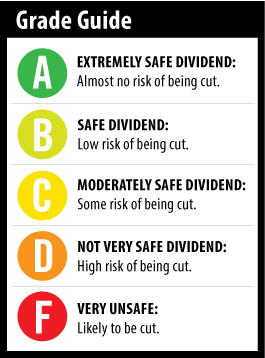 Occasionally, I receive a request to analyze the dividend safety of a company and I don’t even have to do any research to give it a rating.
Occasionally, I receive a request to analyze the dividend safety of a company and I don’t even have to do any research to give it a rating.
For instance, if someone were to ask me about Genuine Parts Company (NYSE: GPC), a stock that has raised its dividend every year since 1956 – and that I know has a low payout ratio – I’d give it an “A.” (Of course, I would do the research to make sure its cash flow is sufficient, but I’d be pretty sure going into it that it would get an “A.”)
Another company whose rating I virtually knew before looking at a single financial statement was KKR & Co. (NYSE: KKR), formerly known as Kolhberg Kravis Roberts & Co. Thanks to Larry W. for the suggestion.
[ad#Google Adsense 336×280-IA]KKR & Co. is a publicly traded private equity firm. It invests in private companies that generate cash flow, and often sells them for a profit.
Over the last four quarters, KKR & Co. has paid out $1.81 per share in dividends for an impressive 7.8% yield.
If you look at Yahoo Finance, it says KKR & Co.’s yield is over 11%.
That’s because its most recent dividend was $0.67 per share. If you extrapolate that over the next three quarters, then an investor would earn more than 11%.
And with most dividend stocks, you can do that.
Going back to the Genuine Parts example: In March, the company raised its dividend to $0.575 from $0.5375. In June, it again paid shareholders $0.575. The company declared the same amount for its September dividend.
But KKR & Co. isn’t most dividend stocks. Its income and earnings are “lumpy” – a term used on Wall Street to mean inconsistent.
No Guarantees
Granted, KKR & Co. has had a steady (although short) track record of annual raises.
The company went public in 2010 and it’s raised the dividend each year.
In 2011, the dividend totaled $0.72 per share. It rose to $0.87 in 2012 and $1.46 in 2013. Through the first two quarters of this year, it has paid out $1.10 per share.
But while I believe investors will make money in the stock and receive a solid dividend over the long term, on a quarter-by-quarter basis, its dividend is entirely unpredictable.
In the second quarter, KKR & Co.’s distributable earnings (which is what the dividend is based on) were $535 million. Last quarter, it totaled $298 million. Last year, over the same time periods, the numbers were $288 million and $832 million.
Because distributable earnings are all over the place, the dividend that is paid to shareholders gets impacted.
For example, the second quarter dividend was $0.67 per share. But because distributable earnings were lower in the first quarter, shareholders received $0.43.
In 2013, the second quarter dividend was $0.42 per share. However, because distributable earnings were so much higher in the first quarter, shareholders received $1.10.
So while KKR & Co. is a solid business – in fact, its co-chairmen and co-CEOs, Henry Kravis and George Roberts, are legends on Wall Street – its business is somewhat unpredictable.
An Income Perspective
 Over the long term, I do believe KKR & Co.’s dividend will continue to rise.
Over the long term, I do believe KKR & Co.’s dividend will continue to rise.
I like the company a lot and believe shareholders will continue to do well.
But for those who rely on dividend income and can’t afford a drop, this dividend is just too unreliable.
Because of the inconsistency of the dividend, I have to give it a low rating.
But keep in mind that the rating reflects only the expectations of a quarterly dividend cut at any time, not my beliefs about the stock itself.
It’s a strong company.
Dividend Safety Rating: D
–Marc Lichtenfeld
[ad#DTA-10%]
Source: Wealthy Retirement


